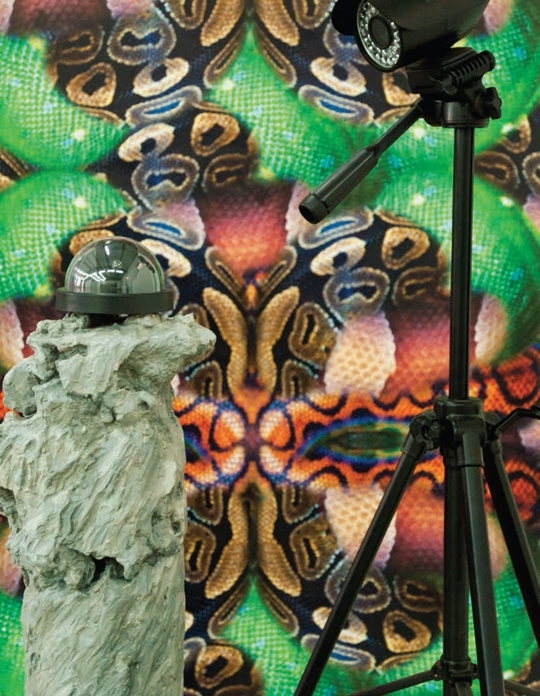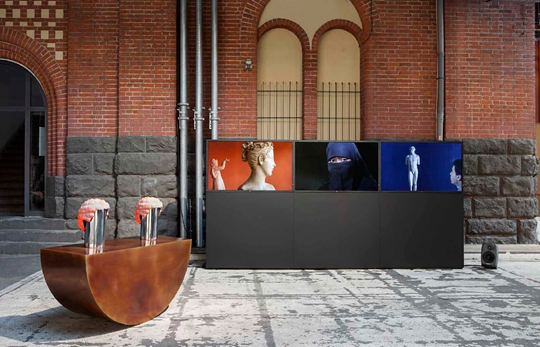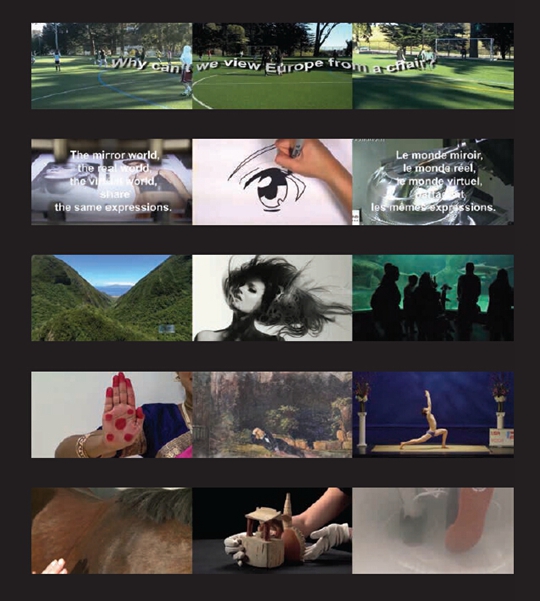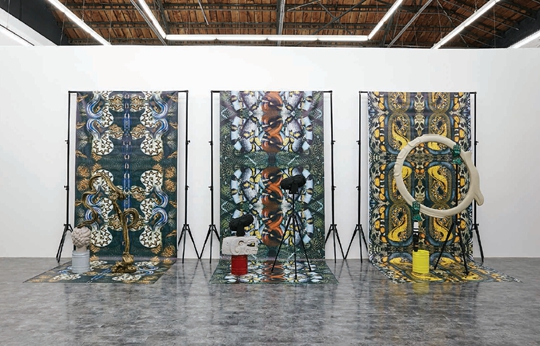Guan Xiao, Rhythm of Singularity
| June 8, 2016 | Post In 2016年4月号

Courtesy Kraupa Tuskany Zeidler and the artist
PHOTO: Benoit Pailley
To be honest, I don’t know how Guan Xiao does it. Looking at the ways she grabs and synthesizes materials in her work, it’s a bit like watching a contestant on The Brain(1) microscopically examining a thousand goldfish. This isn’t a totally apt analogy, for today it’s nearly impossible to quantify—and to describe, even—just how much visual information we receive on a daily basis, via networks both visible and intangible. In this imploding society, everyone is caught in the constant flow of data, always susceptible to some form of attention-deficit hyperactivity disorder. What makes Guan’s work unique is her ability to maintain an extremely high level of concentration while pulling content and motifs from the massive material bank of the internet. In her process, she stays true to an internal worldview that is neither culturally specific nor general. In this dazzling world of data, she finds her own “basic logic” to connect forms.
Guan Xiao works mainly in sculpture and video. For her, these two ways of working depart from polar ends but somehow always meet in the middle. Essentially, her work is about how she understands the world that surrounds her. Whatever medium it may be, she conveys her worldview by weaving myriads of readymade materials and motifs. Seen in this light, Guan’s way of working isn’t as different from an old-school artist’s studio practice as her background might suggest (she entered the art world through a self-enabling engagement outside the conventional academic systems, and describes herself as selftaught), the only caveat being that her paint might be downloaded from the internet. It is probably only natural that her work mirrors the appearance of the online world, as the internet has become the main repository of information for most of us on the planet, and by extension a default source of materials for Guan. Still, her art is by no means a commentary on the platform or tool itself. She is not particularly interested in the discourse surrounding media or technology. Her focus is rather on the universal process of human cognition in the context of information implosion, which she draws attention to through internet imagery and readymade motifs. In fact, much like the writer Kevin Kelly, she likens the internet to our “raw awareness,” “the fact that our awareness has never been fixed since it is always encountering something else. That’s very much like the experience of browsing online.”(2)

Art Berlin Contemporary, 2014
Left:
Rolling Beating, 2014, Colored bronze and car tire, 127 x 48 x 22 cm
Right:
Action, 2014, 3-channel video, 10 min
Courtesy Kraupa-Tuskany Zeidler and the artist
PHOTO: Andrea Rossetti
Guan Xiao’s three-channel video work Cognitive Shape (2013) is a rigorous illustration of her own cognitive process in an overly saturated world of images, as well as her first attempt at using a visual structure of images and symbols to give shape to cognition. She samples some 30 clips from her massive video database comprised of over a thousand clips. Taken from varied sources like YouTube, Vimeo, satellite TV, and DVDs, the found footage is interwoven with her own performance for the camera, narrating rather abstractly the formation of her internal worldview. At one moment in the video, a glamorous shot of an automobile interior, the stamen of a flower, and prosthetic limbs on rotation are juxtaposed, flattened, and equalized on the screen, accompanied by Guan’s soft narration: “concentration, no matter what you concentrate on, as long as you concentrate.” The three heterogeneous elements are stripped of their original context, each gaining a new singularity on the flat surface of the screen. Any dialectical distinction between artificial and natural, living and non-living, becomes irrelevant.
The openness and flattening quality of the internet also provide footnotes to Guan Xiao’s dialectics on the old and new. In her 2012 installation The Documentary: Geocentric Puncture, she devises an installation structure that emphatically calls attention to our ways of seeing in a media-inundated moment. Ancient motifs and sleek technofetishistic forms appear together in what seems like a photography studio from the future. In front of three brightly colored, snakeskin-patterned camouflage backdrops, a heterogeneous range of items with ambiguous cultural and historical backgrounds are placed: tripods, totem poles composed of stacked-up camera lenses, sculptural objects by way of museum artifacts. Pointing out the commonality between forms and the indistinguishability of subjects and objects, Guan deconstructs notions of old and new. What you perceive as a modern structure—the tripod for instance—may in fact be an ancient form. Guan exhibits a hypersensitivity to the new in her work, but attributes this to her intuition for seeing the old and the consistent underlying new creations.

Courtesy Antenna Space and the artist
The instability and cyclical nature of time is another trademark of Guan Xiao’s work. Her first solo exhibition, “Survivors Hunting,” at Magician Space in 2013, presented a series of monumental totems by the name of Cloud Atlas, a nod to David Mitchell’s eponymous novel in which the past and the future collide. Another series in the show, “Core Sample,” a group of metal tripods with a high-tech gleam, are Guan’s translation of the titular scientific concept. The geological term refers to the practice of drilling out a cylindrical piece of material from the earth and studying its vertical strata on the cross section. Information from distinctive dimensions of time and place thereby lay flat on one single plane. Core sampling appears as a key method for Guan, and runs through her earlier work. The strategy of core sampling not only corresponds to Guan’s reading of the world, but also provides her artistic compositions with a structural format.
When trying to comprehend the unfamiliar, our brains tend to establish meaning via binary oppositions and top-down categorizations. Especially in an age when we have become dependent on obtaining answers instantaneously through a click on a search bar, dichotomies like old/ new, fake/ real, male/ female, east/ west, and left/ right provide crude shortcuts for our judgment. This is a cognitive trap that Guan Xiao rejects completely. She doesn’t care much for binaries, arguing repeatedly through her work that the two sides of any concept are often collusive, be it past/ future, nature/ culture, land/ ocean, hunter/ prey, or subject/ object. She eschews boundaries, and prefers to believe that things are in a constant state of flux, always subject to change, or, in her own words, to “endless possibilities of transformation.”

LED lightbox, artificial flower, colored metal, car tire, resin
Lightbox: 308 x 158 cm; wheel and tree stool: 55 x 55 x 80 cm;
wheel and artificial flowers: 60 x 60 x 115 cm
Courtesy Kraupa-Tuskany Zeidler and the artist
A fluid awareness of the self is given shape—in the shape of a dot—in Guan Xiao’s latest three-channel video, Weather Forecast, produced for her upcoming solo exhibitions in France. In it, she narrates: “all things, with individual entity as a line, cut the world into two, with the individual entity as a dot, merge the two into one; ultimately, we’re driven by the things that grab us, merging together, into the sea of all things, and that becomes another dot in another vast world.” With the dot as an element and medium, an individual entity can freely transform into any form of existence, Guan proclaims. Although one might be tempted to read this as a Kantian metaphysical exercise, it is in fact the artist’s Zootopian take on identity politics. The question “Why can’t we view Europe from a chair?” is punctuated throughout the video. This provocation (from someone located outside the continent) is a radical one, especially in the current context, in a Europe besieged by refugee crisis and terrorism. Guan sees an analogy between the fluidity of identity and the change of weather. Every individual can achieve subjective transformation through a series of encounters at any time, any place. Guan offers a possibility of individual emancipation from the normative constraints of identity politics and geopolitics. She rejects cultural representations of any kind that serve the purpose of differentiating one from another. After all, cultural differences and geographical boundaries have already been broken down on the flattening surface of the internet. What attracts her, far more than the differences between humans, is our commonality.
Guan Xiao considers “human” to be the only identity for us, for we all share the same cognitive abilities—the faculties for sensing and feeling—everywhere in the world. A universal discussion of our cognitive experiences is central to Guan’s practice. In her work, she persistently looks for a common, and hybrid, method of communication, one that transcends language and culture, that humans everywhere can receive. This communication is delivered in the form of rhythm in her video Action (2014). She sees rhythm as a common denominator of everything that can be understood—all living things and existences in the material world have their rhythms. Rhythm is the linkage that connects you and me, and a stone and a wig: “Everything meets constantly. In the frequency of the universe. Resonate together.” Guan choreographs shapes, sounds, text, humans, objects, animals, plants, clouds, and actions into a rhythmic celebration of human agency—our profound ability to perceive, act, and become.

Fiberglass, camera tripods, spot lights, camera lens models, brass, digital print on vinyl, background stands 700 x 176 x 300 cm
Courtesy Antenna Space and the artist
The fact that Guan Xiao eschews any geographical or cultural framework when discussing her work and identity is remarkable, even among today’s cosmopolitan set of young Chinese artists. Identity labeling is closely tied to one’s visibility on a larger scale in the contemporary art world, and elsewhere. Some might worry that an absence of discourse around identity politics and ideology among younger artists today doesn’t serve well for national branding on a global stage, but Guan’s practice points to another possibility: the artists that have come of age with the proliferation of the internet no longer share the insecurities that propelled the statements of generations before “Without going to New York and Paris, life could be internationalized.” In their life and practice, artists like Guan willingly embrace postmodernity as a levelling force that shapes them into a new form of being—a “whatever singularity,” as Giorgio Agamben terms it. In his book The Coming Community, Agamben envisions a “new planetary humanity” that rejects any manifestation of identity or belonging: “the singularities form a community without affirming an identity, that humans co-belong without any representable condition of belonging.”(3) For a post-ideological society entrenched in the global economy, this could very well be the most radical solution to identity politics yet.
————————-
(1) The Brain is a popular scientific reality and talent show in search of people with exceptional brainpower in China.
(2) Interview with Nav Haq, Mousse, Issue 45, 2014
(3) Giorgio Agamben, The Coming Community. Trans. Michael Hardt, University of Minnesota Press, 1993, p. 86.

